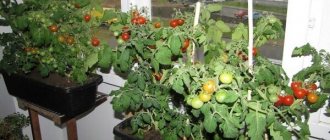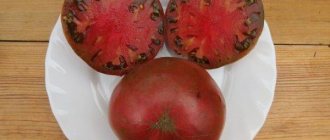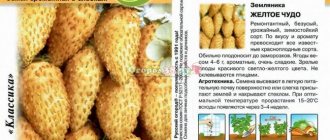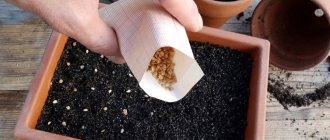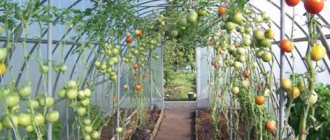Description of tomato Miracle of the Earth
The official tomato variety Miracle of the Earth, bred by Novosibirsk breeder-entrepreneur V.N. Dederko, was included in the State Register in 2006. The resulting species is truly a miracle of selection.
Miracle of the Earth supplies high-quality tomato seeds to the agro market. Vegetables can be grown almost everywhere in Russia and neighboring republics in open ground or greenhouses.
The bushes of the plant are tall (up to 2 m), indeterminate, and characterized by intensive growth. However, the stems are not too thick, so they need good support. The leaves are usually medium in size, dark green in color, and often curl, which is their distinctive feature, not a disease. Inflorescences of intermediate type.
Experienced gardeners recommend forming a bush of 1-2 stems, mercilessly removing all the stepsons. A fork in the stem is formed under the first cluster with flowers: this will result in a double-stemmed plant, on which clusters of large fruits will soon appear. The tomato variety Miracle of the Earth is a mid-season variety; the first pink tomatoes can be picked from the bush after 120 days.
Description of fruits
Tomato fruits are a real achievement of Russian selection; they are good in all respects:
- The weight of ripe fruits usually reaches 400 g, but there are tomatoes weighing about a kilogram. At the same time, vegetables are not prone to cracking.
- Unripe tomatoes usually have a greenish spot at the point where the stalk attaches. When ripe, the color of tomatoes turns raspberry-pink.
- The shape of the Miracle of the Earth tomatoes is round, slightly flattened with slight ribbing. There are practically no deviations in form.
- The skin of miracle vegetables is thin, barely noticeable, but quite durable.
- The taste of tomatoes is excellent, tender, sweetish.
- The fruits contain from 5 to 7% dry matter, have a small number of seeds, which, when fully ripened, can be used to independently grow tomatoes next year.
These characteristics of the fruit, as well as some of the benefits of the crop, which will be discussed later, make the variety very popular among farmers and amateur gardeners.
Reviews from vegetable growers
Positive reviews about “Miracle of the Earth” tomatoes encourage even a beginner to grow this variety and get a harvest of tasty large tomatoes on their own.
“I bought the seeds on the advice of my neighbors in the country. At first it was scary that the stems grow very quickly. All fear disappeared when large, beautiful fruits hung on the branches. I treated it for late blight only once. It's amazing that they bear fruit for a long time. I’m very pleased that I tried to grow it” - review by Nikolai Miroshkin.
“I used to buy seeds of a different variety. They did not bear fruit for long, and the fruits were of medium size. There was only enough for the summer, to prepare a couple of dishes and cut salads. I decided to plant “Miracle of the Earth” because of the positive reviews about it, and was pleased with the result! The harvest was much larger than from the previous variety, although the same efforts were expended!” — review of Maria Shevchenko.
Characteristics of tomato Miracle of the Earth
When creating the tomato variety Miracle of the Earth, breeders pursued the goal of obtaining a record holder among tomatoes for many characteristics. The goal was achieved, now vegetable lovers can themselves appreciate the merits of miracle tomatoes.
Productivity and fruiting
Most of the famous large-fruited tomatoes belong to mid-late varieties, but not miracle tomatoes. The first harvest begins 4 months after the seedlings are planted in the ground, and the harvest continues until the cold weather.
The yield of large-fruited tomato varieties is usually up to 15 kg per 1 m2 of land. If the summer turns out to be warm, you can expect greater fertility of the crop, but it will not fail even with temperature fluctuations.
The variety has ecological plasticity, i.e. adapts to grow and bear fruit in any region of the country and neighboring countries. In warm climates, the yield will be up to 20 kg per 1 m2, in northern latitudes - up to 12 kg. Feedback from farmers about the productivity of Miracle of the Earth tomatoes and photos confirm the data presented.
Area of application of fruits
The best use for tomatoes is to process them or quickly use them fresh. Fragrant, juicy vegetables make excellent pastes, juices, and winter dressings. Lovers of fresh tomatoes will not remain indifferent to the excellent taste of the juicy fruits of the Miracle of the Earth.
Attention! Large tomato fruits do not withstand long-term storage and transportation.
Resistance to diseases and pests
There is evidence that tomatoes of the described variety are quite resistant to pathogens. However, standard preventive measures to protect plants from microorganisms and pests should not be neglected.
According to numerous reviews from gardeners, plants grown in open areas are not susceptible to late blight. But there have been cases of infection with tobacco mosaic or brown spot. Greenhouse tomato crops are more susceptible to infection.
From time to time, the miracle variety, grown both in a greenhouse and in open areas, may be attacked by pests. Detailed information about effective measures to combat and prevent plants from parasites is presented below.
Advantages and disadvantages of the variety
Based on reviews from gardeners who grew Miracle of the Earth tomatoes, we have prepared a list of advantages of the variety:
- excellent taste characteristics of tomatoes;
- high yield level compared to other pink varieties;
- drought resistance, as well as the ability to grow and produce a good harvest in cold regions of the country;
- good presentation of vegetables;
- no tendency to crack;
- fairly stable immunity when grown on open land;
- the ability to independently obtain seed material;
- long period of fruit ripening.
The culture has few disadvantages. These include:
- the need for pinching bushes to obtain a rich harvest;
- need for garter;
- presence of fake seeds on the market.
Advantages and disadvantages, differences from other varieties
Despite the relative youth of the variety, its most important advantages and disadvantages have long been revealed, and in numerous discussions, experts and amateurs agree that the Miracle of the Earth is a very worthy tomato, and even a not very experienced vegetable grower can grow it without problems in almost any climate. The main advantages of the variety are:
- spectacular appearance of the fruit;
- large fruit;
- very high and stable yield;
- good or even excellent taste, versatility of use;
- drought and cold resistance;
- transportability of the harvested crop and its relatively long shelf life;
- increased disease resistance.
In addition, a positive property is that the seeds collected from their harvest completely retain varietal characteristics and can be used for planting tomatoes in subsequent seasons.
The relative disadvantages of the variety are:
- mandatory procedure for forming bushes, as well as tying stems;
- exposure of bushes to strong winds, from which they can break even if there are good supports.
It is clear that these shortcomings are not critical. Moreover, among the varieties that produce such high yields of large-fruited fruits, there are probably none that can do without tying. And the absolute majority of varieties and hybrids require formation. The peculiarity of the variety is, rather, that in order to obtain such harvests it does not require any supernatural knowledge and effort from the gardener.
The fruits of this variety are very similar to the fruits of the Velmozha tomato, but in the latter they are somewhat smaller and more even, and the overall yield is lower. However, both of these varieties were born in Siberian conditions, both are resistant to the vagaries of the weather. Breeder V.N. Dederko also owns a wonderful variety of Koenigsberg tomatoes, which bears fruit with tasty large tomatoes of various colors, but smaller and elongated ones. The well-known Bull's Heart tomato, which differs in appearance from the Miracle of the Earth, perhaps only in color, ripens a little later. Actually, diversity gives rise to choice...
The miracle of the earth is often compared to the Ox's Heart, but their fruits have different colors
Growing rules
To get a good harvest of Miracle of the Earth tomatoes, you need to purchase high-quality seed material and follow agricultural cultivation techniques.
Planting seedlings
Seeds for seedlings should be prepared in advance, because they begin to germinate 2 months before the intended planting in the ground. First, the seeds are poured into the water, and those that float are thrown away because they are not able to germinate. The remaining seed is placed for 30 minutes for pickling in a weak solution of potassium permanganate or peroxide, heated to 40 degrees.
Seeds can be germinated in a damp cloth, or they can be immediately planted in prepared pots or a common container with moistened, light, loose soil. To do this, make 0.5-1 cm depressions in the ground at a distance of about 5 cm. A seed is placed in each hole, sprinkled with soil, and covered with polyethylene. The containers are placed in a warm (20-25°C), bright place until sprouts appear. Then the film is removed and the ground is moistened with a spray bottle. After 7 days, the air temperature is reduced to 19-20 degrees.
Important! Seedlings must be hardened by taking the containers out onto the balcony or street for several hours, provided that the temperature does not drop below 10°C.
Tomato transplant
Fortified two-month-old seedlings are planted in open ground after the frosts have passed and the soil has warmed up. For the first few days, you can cover the young shoots with film. For 1 sq. m. place no more than three two-stemmed bushes or four plants with one stem.
Subsequent care for tomatoes
When transplanting sprouts to a plot or greenhouse, you need to take care of installing reliable supports for miracle tomatoes. Pinching is carried out after the plants reach 7-8 cm in height, the procedure is carried out every week until mid-July. Leaves located on the stem below 30 cm are torn off.
Vegetables are watered as the soil dries out. If the soil around the tomatoes is mulched, moistening should be done no more than once a week. It is preferable to water the bushes early in the morning or after sunset. When a crust forms on the surface of the soil, do not forget to loosen it.
Tomatoes require regular feeding; only with their help will it be possible to grow record-breaking miracle fruits. When planting bushes, ash is placed in the hole. To increase green mass at the stage of leaf formation, the soil is fertilized with nitrogen-containing substances, for example, urea. During the flowering period of tomatoes, it is necessary to use fertilizers to increase the formation of ovaries, such as KKM 1. And when the fruits begin to form, nitrogen fertilizing is stopped. Experienced gardeners recommend treating tomatoes with Agricola during this period.
When growing Miracle of the Earth tomatoes in greenhouse conditions, you should maintain the optimal temperature and humidity conditions (27-30 ° C and 50-60%) and manually pollinate the flowers.
Reviews from gardeners about both varieties
Natalya, 37 years old, Ryazan region.
Last year I planted both varieties of the Miracle of the Earth variety (from the Siberian Garden and Ukrainian ones) side by side in the greenhouse. The domestic fruits pleased us with their taste and size: large (the largest is 650 g), sweet, with sugar pulp and a real tomato aroma. Almost everything was eaten fresh. Only the last ten were processed into sauce, which also turned out very tasty.
There were a lot of tomatoes of Ukrainian selection, and the taste was also good. They grew up heart-shaped, medium in size, but for some reason red in color (and not pink, as was written on the package). Perhaps I encountered a mismatch. Now I don’t know what kind of variety it was, but it’s a pity: I grew it without problems, and I liked the tomatoes, especially in the marinade.
Anna, 42 years old, Perm region
This variety of tomatoes is one of my favorites. I've been growing it for several years now. Initially I bought seeds from the Siberian Garden, but the rest of the years I used my own. In general, there are not very many seeds in the fruits, but it is not difficult to collect enough from the best specimens to be enough for your needs.
Tomatoes are beautiful, tasty, aromatic. A great option for summer salads. Ripe ones, however, are almost never stored, but this is not required. There are usually no problems when growing: I plant it in a greenhouse, form bushes with 2 stems, and do 1-2 treatments for fungal diseases per season. If you remove all the lower leaves in time, late blight does not affect the bushes.
I am very pleased with this variety. Fruitful, tasty and practically problem-free.
Anton, 51 years old, Michurinsk
I have a variety from “Sib. Sada has been bearing fruit beautifully in open ground for several years now. The tomatoes are very large (there were specimens of 800 and 900 g). The taste is decent, the yield is at the level. I didn’t notice any difficulties with growing, but the plants need to be tied up, and not only each stem, but also the individual ripening clusters, so that the fruits do not break the bush.
For next summer I bought seeds of a similar variety of Ukrainian selection. The picture shows that it differs from the Russian one: the fruits are heart-shaped. The packaging says they will grow large. I will try and compare.
Pest and disease control
To get healthy plants, it is necessary to prevent diseases. The tomato variety is quite resistant to common pathogens. Nevertheless, the soil should not be allowed to become waterlogged and it is advisable to choose the right neighbors for tomatoes.
If infection does occur, measures should be taken immediately:
- areas of plants affected by the tobacco mosaic virus must be destroyed, and the sections must be treated with a solution of potassium permanganate or crushed coal;
- to treat cladosporiosis, tomatoes are treated with copper oxychloride or a mixture of water, milk and iodine in a ratio of 5 l: 0.5 l: 15 drops;
- when attacked by greenhouse whitefly, the drug Confidor, diluted 1:10, will help;
- slugs and ticks are repelled by hot pepper solutions.
Harvest and storage times
The first ripe tomatoes of the Miracle of the Earth variety are harvested 90 days after the seeds germinate. The bulk of the harvest is harvested from late summer to early autumn. During this period, you need to inspect the tomato bushes daily and immediately remove ripe fruits so that they do not create additional stress on the branches of the plant. You need to pick tomatoes when their color turns bright pink, but before they become soft.
We recommend reading how to properly store tomatoes at home.
You need to store Miracle of the Earth tomatoes in a dry and cool place, a basement or cellar is suitable. Tomatoes are placed in clean wooden or plastic boxes. In such conditions they can be stored for up to 14 days.
Planting and propagation
The variety has an average ripening period, which imposes its own nuances on the time of planting seeds.
Sow the seeds
So, if you want to get a tomato harvest a little earlier, then you need to sow the seeds on February 20-23.
If you want to get ripe tomatoes a little later, then we plant the seeds in early March. The desired time for sowing seeds is 55-65 days before planting directly into the ground.
You can sow the seeds dry, but, according to some summer residents, this approach gives more mediocre results than pre-soaking the seeds for a day in Epin.
If you collect the seeds yourself, we recommend soaking them for an hour in a weak solution of potassium permanganate before planting them in the ground. Then leave the material to soak overnight in water at room temperature.
After soaking, you can immediately plant the seeds in the ground, or you can put them in wet gauze and wait until they hatch, and then plant them in the ground.
How to plant seeds is a personal matter for each gardener; you can experiment and choose what works best for you.
After the seeds are sown in the container, you need to cover the container with the seedlings with a plastic bag or film. Then we put the future seedlings in a dark place until the first seeds hatch. Next, we move our plants to a place where there is enough sunlight.
Landing in the ground
So, our seedlings have grown.
We take it outside for a day every day, about 1-2 weeks before planting. You can pick plants when they have 2-3 true leaves.
We plant tomatoes at the rate of 2-3 plants per 1 m2, no more. Otherwise, they may not have enough nutrients. If the plant is planned to be formed into 1 stem, then up to 4 bushes can be planted per meter.
We adhere to the planting pattern of 50 by 60 cm.
Similar varieties
Large-fruited tomatoes with similar characteristics and description of the variety:
- Grandma's secret is tall, with a ripening period of 110 to 115 days. The fruits are pink, flat-round, weighing 350-700 g. They have a sugary taste and fleshy pulp.
- King of the Giants is an indeterminate mid-season cultivar with a ripening period of 100-110 days. Suitable for growing in open and closed ground. Vegetables are round in shape, colored red, weigh 400-700 g, on the first bunches up to 900 g. They stand out for their taste and high yield.
- The Soviet tomato variety is a tall plant with a ripening period of 115-120 days. Large-fruited, bright pink tomatoes weighing from 680 to 750 g. There is a pronounced greenish spot at the base. It has aromatic fleshy pulp with a sweetish taste.

